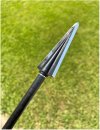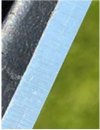We all want our heads to be as sharp as possible, that's obvious and really not the topic here.
Lots of us think our heads are sharp.sharp.. "Hey the ad said said sharp right out of the package and they were pretty good when the mailman delivered them to my door. Maybe. Some guys just don't what "sharp" really is.
There is no such thing as "too sharp" or "sharp enough" .
I realize this thread is gonna morph just like they always do but my #1 question is how many of you you that sharpen your own heads are anal about the finer points?
Yeah, we all have of preferences of how to leather strop, cardboard strop, etc, and that should be a standard discussion.
Big question...
Do you pay any attention to the actual direction/angle of the microscopic scratches you put in in the steel when you hand sharpen?
I noticed many years ago, whether it's a broadhead or a kitchen knife, that the cut of blades is DIRECTIONAL. Run a blade in one direction and id cuts better than if pulled in the opposite direction. The action of a cut is microscopic. Even if we can't see it with the naked eye, an edge has microscopic scratches in it. Those scratches do indeed "channel" flesh, arteries and other goodies INTO the blade edge. It's a minor detail... MAYBE. A barely nicked artery can make the difference between a recovery and a sob story.
When I sharpen a kitchen knife or a broadhead, I can definitely feel the difference in sharpness based on the direction of the cut or the direction of the scratches of the sharpen. Broadheads cut in a forward direction. Sharpen them in the direction in which they will penetrate/cut.
Yeah, it maybe a minor, anal detail, but you might feel different about that detail on a difficult blood trail.
The angle of scratches during sharpening in my experience, makes a difference in how sharp the head cuts during penetration.
Lots of us think our heads are sharp.sharp.. "Hey the ad said said sharp right out of the package and they were pretty good when the mailman delivered them to my door. Maybe. Some guys just don't what "sharp" really is.
There is no such thing as "too sharp" or "sharp enough" .
I realize this thread is gonna morph just like they always do but my #1 question is how many of you you that sharpen your own heads are anal about the finer points?
Yeah, we all have of preferences of how to leather strop, cardboard strop, etc, and that should be a standard discussion.
Big question...
Do you pay any attention to the actual direction/angle of the microscopic scratches you put in in the steel when you hand sharpen?
I noticed many years ago, whether it's a broadhead or a kitchen knife, that the cut of blades is DIRECTIONAL. Run a blade in one direction and id cuts better than if pulled in the opposite direction. The action of a cut is microscopic. Even if we can't see it with the naked eye, an edge has microscopic scratches in it. Those scratches do indeed "channel" flesh, arteries and other goodies INTO the blade edge. It's a minor detail... MAYBE. A barely nicked artery can make the difference between a recovery and a sob story.
When I sharpen a kitchen knife or a broadhead, I can definitely feel the difference in sharpness based on the direction of the cut or the direction of the scratches of the sharpen. Broadheads cut in a forward direction. Sharpen them in the direction in which they will penetrate/cut.
Yeah, it maybe a minor, anal detail, but you might feel different about that detail on a difficult blood trail.
The angle of scratches during sharpening in my experience, makes a difference in how sharp the head cuts during penetration.




